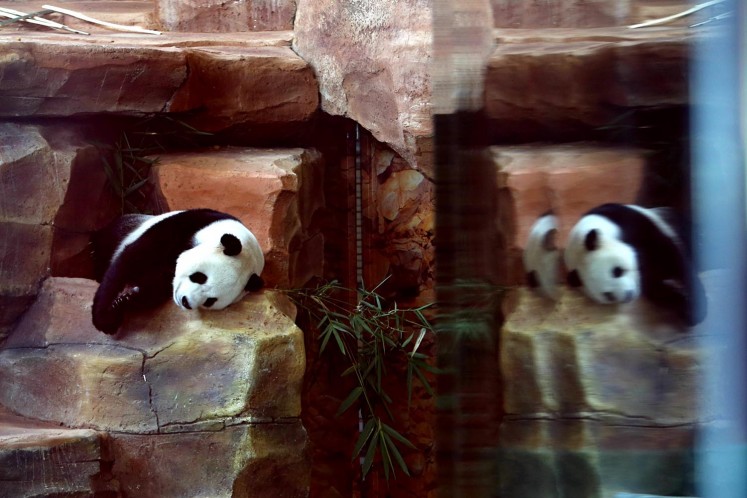Popular Reads
Top Results
Can't find what you're looking for?
View all search resultsPopular Reads
Top Results
Can't find what you're looking for?
View all search resultsFeeding: A serious business at the menagerie
Change text size
Gift Premium Articles
to Anyone
O
blivious to many visitors, the dietary peculiarities of the denizens of Bogor’s Taman Safari Indonesia means feeding them is serious business.
Many visitors to Taman Safari Indonesia, the popular safari park in Bogor, West Java, feed the park’s already well-fed animals for fun and to feel good about nurturing the animals.
However, “Visitors are not allowed to feed animals with food other than the food provided by the park”, said the park’s director, Jansen Manangsang. This is “to prevent the ingesting of harmful objects and transfer of disease”, he clarified, although he acknowledged that such behavior among visitors was common and part of their experience.
Moreover, giving the animals food doesn’t necessarily come from genuine care or love for the animals. Some visitors just want to find out “what would happen if […]”, and make fun of the menagerie’s inhabitants.
A case in point is giving local wine to a hippopotamus and a blackbuck antelope in November 2017.
Such behavior indicates that visitors are generally oblivious to the dietary needs of the safari park’s denizens, and feeding them is serious business.
Jansen recalled that the first seven to eight Sumatran rhinoceroses(Dicerorhinus sumatrensis), which were rescued from the jungles affected by oil drilling operations in Riau, all died due to the wrong food. Back in 1997-1998, no one — not even senior experts, biologists and conservationists — knew what the solitary animal ate.
“We thought they ate grass. So we gave them grass and fruit, only to find that all of them died as a result. That was a terribly painful and expensive lesson I learned the hard way,” he said. It was later discovered that the critically endangered species eats twigs, tree saplings, shrubs and shoots.
Another feeding mistake involved meerkats, small carnivores of the mongoose family. The park fed crickets to the primarily insectivorous animals, locally and abundantly available, but the small burrowing animals died as a result.
Despite being natural predators of the scorpions of the Kalahari Desert and even immune to their very strong venom, meerkats cannot eat diets high in iron. Crickets have more than three times as much iron as beef (100 grams of crickets contain 9.5-10 mg of iron, while a 100 gram serving of beef tenderloin provides 3.1 mg of iron).
Experience also taught him that a diet of chicken will make tigers susceptible to osteoporosis.
At home: Male giant panda Cao Tao rests in his enclosure at Taman Safari Indonesia in Bogor, West Java. Two pandas are at the park on loan from the Chinese government as part of a breeding loan program. (JP/Seto Wardhana.)However, with the park’s newest, high-profile foreign dignitaries, two giant pandas on loan from China named Cao Tao (male) and Hu Chun (female), Jansen has enjoyed relative success.
Since their arrival in September 2017 to the Chinese-themed Panda Castle, Cao Tao has put on about 1 to 2 kilograms, but Hu Chun gained 10 kg, so she had to be put on a weight management program. “Now, she has lost 2 kg — still 3 kg shy of the ideal weight,” he said.
Read also: Seven best photo spots at Indonesia's Panda Castle
Jansen attributed their increased appetite to: “the better taste of our homegrown bamboos, thriving in fertile soil and an unpolluted environment where forest cover accounts for 85 percent”.
The Panda Castle itself is nestled on a misty mountain slope at 1,800 meters above sea level, with temperatures ranging from 15-24 degrees Celsius, adjacent to the pristine Mt. Gede and Mt. Pangrango National Park.
Jansen said the Panda Castle had much cleaner air than Malaysia’s Negara Zoo in Kuala Lumpur, which also has pandas loaned from China, or even China’s Chengdu Zoo, where the air quality index often borders on the unhealthy.
“If only the luxury treatment the pandas enjoy can be lavished on all the animals here,” said Jansen.
Providing the natural foods that wildlife species eat requires specific knowledge and resources, and even nature itself can be deprived of such foods if the yin and yang of its ecosystems is disrupted.
However, the duty and science of feeding the park’s animals are often taken for granted, and the opportunity and comfort Taman Safari provides to visitors to observe them in close proximity is rarely seen as an invaluable occasion to appreciate and reconnect with our fellow creatures of the Garden of Eden.












